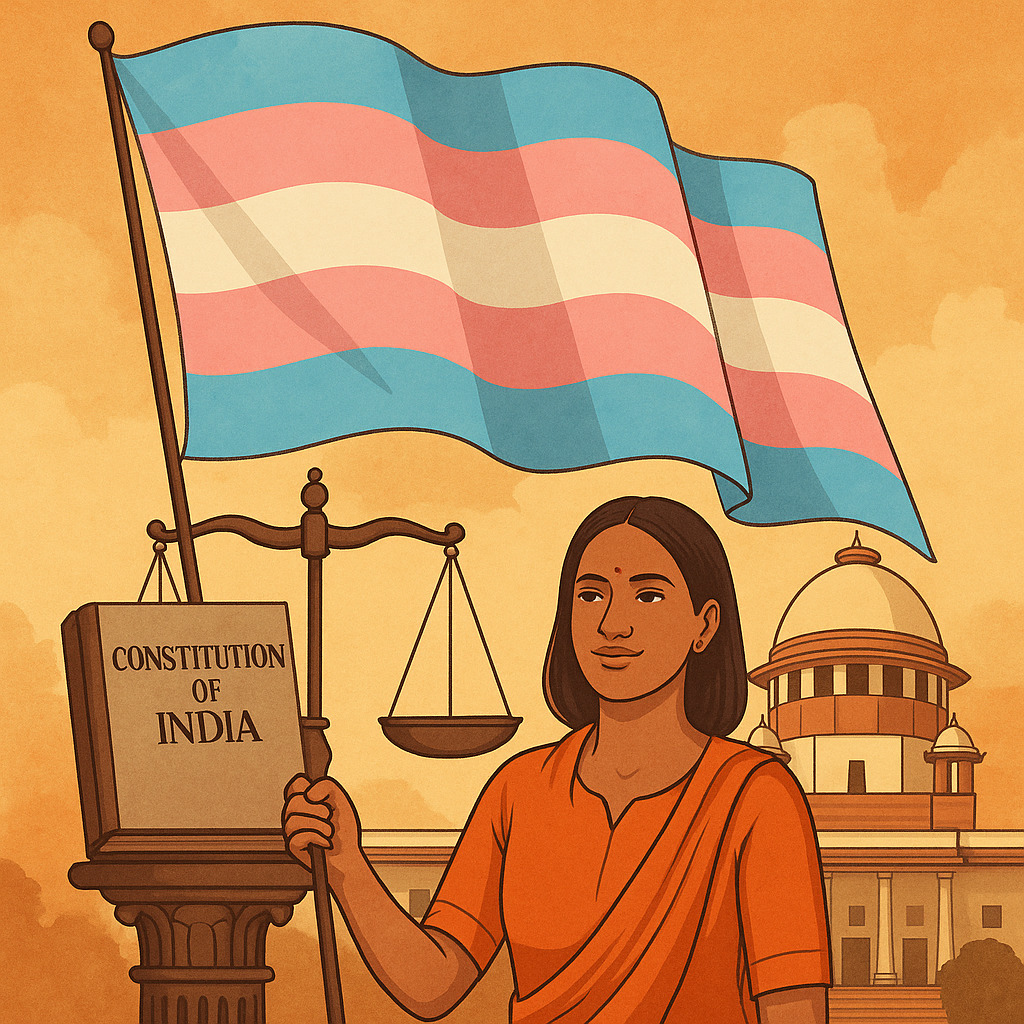View News
Basic-Rights-of-Transgender-Individuals-in-India-Legal-Struggles-and-Advancements-in-the-Legal-and-Economic-Environments

Basic Rights of Transgender Individuals in India: Legal Struggles and Advancements in the Legal and Economic Environments
~Sura Anjana Srimayi
Introduction
The recognition and enforcement of basic rights for transgender individuals in India have been a protracted and evolving journey. Systemic discrimination and long-standing marginalization have left the transgender community excluded from many societal benefits. However, judicial pronouncements and growing social awareness have driven significant progress. While legal recognition has been achieved to a considerable extent, real-world economic empowerment and social acceptance remain limited. This article explores the legal developments, continuing challenges, and emerging opportunities in the quest for equality for transgender individuals within India’s legal and economic framework.
Constitutional Framework and Recognition of Transgender Rights
Although the Constitution of India does not explicitly refer to transgender persons, its fundamental rights have been interpreted by the judiciary to encompass the transgender community. The following constitutional provisions have played a pivotal role:
Article 14: Equality Before Law
Article 14 guarantees equality before the law and equal protection of the laws. The Supreme Court’s landmark judgment in National Legal Services Authority (NALSA) v. Union of India (2014) recognized transgender persons as the "third gender," affirming their right to equality and protection from discrimination under this Article.
Article 15: Prohibition of Discrimination
Article 15 prohibits discrimination on grounds of religion, race, caste, sex, or place of birth. The NALSA verdict interpreted “sex” to include gender identity, thus extending constitutional protection to transgender individuals against gender-based discrimination in areas like education, employment, and public services.
Article 16: Equal Opportunity in Public Employment
Under Article 16, transgender individuals have the right to equal opportunity in public employment. The NALSA ruling emphasized the inclusion of transgender persons in government posts and urged the adoption of affirmative action policies.
Article 21: Right to Life and Personal Liberty
Article 21 ensures the right to life and liberty, including the right to live with dignity. The Supreme Court recognized the right of individuals to determine their own gender identity as an essential component of personal liberty.
Key Legal Milestones and Policy Developments
India’s legal landscape concerning transgender rights has evolved through several critical interventions:
1. The NALSA Judgment (2014)
This landmark decision recognized transgender persons as the third gender and mandated legal recognition of their gender identity. The Court directed central and state governments to ensure their access to healthcare, education, and employment while calling for affirmative action to redress historical discrimination.
2. The Transgender Persons (Protection of Rights) Act, 2019
Enacted to reinforce the NALSA ruling, the 2019 Act prohibits discrimination in various domains including education, employment, and healthcare. It introduces identity certificates acknowledging self-perceived gender identity. However, the requirement for a medical evaluation in some cases has attracted criticism.
3. The Transgender Persons (Protection of Rights) Rules, 2020
These rules were formulated to streamline the implementation of the 2019 Act and respond to widespread concerns about procedural hurdles in acquiring identity certificates. However, certain contentious provisions remain under judicial scrutiny.
4. Ongoing Judicial Review
In 2023, the Supreme Court took up petitions challenging parts of the 2019 Act, especially those affecting gender recognition processes. The Court acknowledged the importance of a rights-based framework that respects self-identification.
Persistent Legal and Bureaucratic Challenges
Despite legal victories, transgender individuals face numerous obstacles in exercising their rights:
1. Inconsistent Implementation
The enforcement of legal protections remains uneven across states and government bodies. Many policies are poorly implemented or ignored, creating disparities between legal entitlements and lived realities.
2. Administrative Barriers
Obtaining identity certificates under the 2019 Act remains a complex and often humiliating process due to lack of awareness and sensitivity among government officials.
3. Absence of Affirmative Action in Education and Employment
Despite the Supreme Court's recommendations, the lack of concrete reservations for transgender persons in education and public employment significantly hampers their economic advancement.
4. Persistent Social Stigma
Legal protection has not eradicated societal prejudice. Discrimination in housing, healthcare, and social settings continues. For instance, in 2024, multiple reports surfaced of transgender individuals being denied rental housing solely due to their gender identity.
Economic Exclusion and Structural Vulnerabilities
The legal marginalization of transgender individuals is tightly linked to economic hardship. Key areas of concern include:
1. Employment Discrimination
Transgender persons face high levels of unemployment or underemployment, often restricted to informal sectors prone to exploitation. A 2023 survey by an LGBTQ+ advocacy group found rampant job discrimination during recruitment stages.
2. Educational Barriers
Limited access to education—due to both past exclusion and ongoing stigma—prevents transgender individuals from acquiring necessary qualifications and skills.
3. Financial Exclusion
Transgender persons frequently face difficulties in accessing banking and credit services due to lack of recognized identity documents and institutional bias.
4. Healthcare Inequities
Access to gender-affirming and general healthcare remains inadequate. High costs and discriminatory treatment from medical professionals worsen their financial and physical vulnerability.
Positive Developments and Emerging Trends
Despite challenges, several positive trends have emerged:
1. Enhanced Awareness and Advocacy
Growing advocacy from civil society and visibility of transgender voices in media have been instrumental in shaping public opinion and influencing policy reform.
2. Progressive Government Measures
Some state governments have introduced transgender-inclusive welfare programs, job reservations, and skill-building initiatives. Notably, in 2024, a southern state launched a recruitment drive with reserved public sector positions for transgender candidates.
3. Corporate Inclusion
A few progressive companies are embracing inclusive workplace policies. In 2025, a leading Indian multinational publicly committed to enhancing transgender representation and announced measures for gender-affirming care and inclusive facilities.
4. Judicial Vigilance
The judiciary continues to play a proactive role in upholding the rights of transgender individuals and ensuring the enforcement of protective legislation.
Conclusion
India’s legal and policy landscape for transgender rights has undoubtedly advanced, particularly with the recognition of the third gender and the enactment of protective legislation. Yet, substantial gaps remain between legal affirmation and everyday experiences. Bridging these gaps requires:
-
Removing bureaucratic roadblocks in gender recognition processes.
-
Introducing explicit reservations in education and employment.
-
Addressing systemic discrimination in housing, healthcare, and financial services.
-
Ensuring sensitization at all levels of government and society.
The growing collaboration among government bodies, judiciary, civil society, and the corporate sector signals hope for a more inclusive future. Sustained advocacy and policy innovation are essential to ensuring that the basic rights of transgender individuals are not merely enshrined in law but fully realized in practice.
"Unlock the Potential of Legal Expertise with LegalMantra.net - Your Trusted Legal Consultancy Partner”
Disclaimer: Every effort has been made to avoid errors or omissions in this material in spite of this, errors may creep in. Any mistake, error or discrepancy noted may be brought to our notice which shall be taken care of in the next edition In no event the author shall be liable for any direct indirect, special or incidental damage resulting from or arising out of or in connection with the use of this information Many sources have been considered including Newspapers, Journals, Bare Acts, Case Materials , Charted Secretary, Research Papers etc.

